But they lacked an international identity. This was the beginning of the Japanese obsession in the eighties to get into any kind of international competition. It could be F1, where Honda had been participating for years, it could be Le Mans, or it could be rallying.
Nissan and Toyota had tried their hand at world rallying in the Group B era and even before, but it was Subaru and Mitsubishi (and that's two dates for the diamonds) who, in the late eighties, were on their way to making history.
The Fuji Heavy Industries company had its Legacy RS racing on the world championship tracks. That was the first product designed by Subaru to try to build an international reputation, especially in the demanding North American market, selling what we would consider a D-segment sedan, which in the RS version was equipped with a powerful two-liter supercharged boxer and paired with an all-wheel drive system. The result was a technically differential proposal to everything known in the market.
The Legacy served just what Subaru intended, but it was too big for the trails, and, in view of the success of the repositioning of the brand towards a more prestigious approach, the Impreza range was launched, aimed at the C segment, which in its sporty version WRX inherited the EJ20G engine from the Legacy. Thus was born a saga that, from 1994, 20 years ago, would give rise to the WRX STI that has come down to the present day.
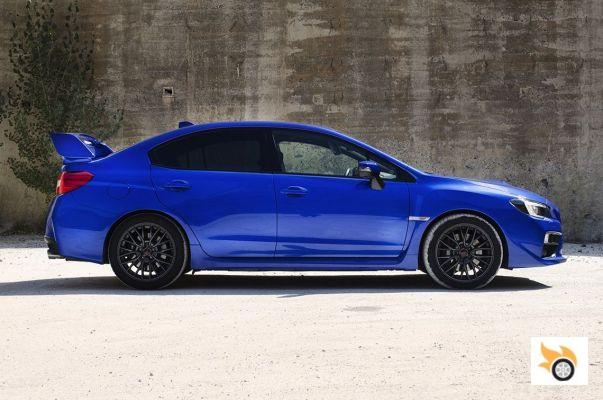
Subaru probably couldn't even dream that the WRX STI would become a cult item.
The problem for Subaru was that the success and the passions raised by the Impreza WRX STI were unexpected. The sporting successes coupled with the car's unstylish, uncool aesthetics (it was a run-of-the-mill three-volume from the bland era of Japanese design in the 1990s, with no product personality whatsoever) made a growing number of enthusiasts fall in love with the technology, the handling and the performance of the product.
But it had to be evolved and revolutionized, and the problems began. Reinventing a successful myth is always complicated. From the first WRX STI to the one known as "frog eyes", an aesthetic disaster for most that required deep cosmetic surgery, although the fact that Richard Burns won the World Championship with it made up a little bit of its history.
But the real problems came when Subaru decided in 2008 to give the Impreza another twist. They wanted to stop being "the rally car brand" and have a C-segment product that was competitive with the Golf and company. They wanted to move away from the stigma that everyone who saw an Impreza expected a passionate driver. They wanted more generalism to make more volume. Big mistake. People weren't ready for it. Worse, this generation's WRX STI would be late to be born and would be born with a much less racing tuning.
The brand's exit from the WRC didn't help the sales and reputation of the product either, but there was hope for the STI to rise from the ashes. In an attempt to decouple Impreza and WRX STI, the brand went on to drop the Impreza name from the model. And in fact, if you notice, the regular Impreza isn't even sold in most markets in Europe anymore, including Spain, where there's only WRX STI and XV as derivatives of that Impreza family.
That's how we got to 2014, the launch of the new STI in Europe, and the challenge the brand had before it to recapture "the essence", the DNA of the original WRX STI.
The problem? Well, things have changed a lot. What in 1994 or 1996 was an explosive, radical, technologically advanced, cutting-edge engineering car is now faced with the stark reality that competing compact sports cars are just as powerful and fast, at least on paper, and cost just as much. A problem for this giant-killer.
But perhaps the point of this car is in knowing how to understand it. With all this on the table, we asked the people at Subaru Spain to give us "as much time as possible" (a month at the end), the WRX STI, to solve many questions at the same time.
Was it a worthy heir to the saga? Could it keep up with the growing and increasingly prepared competition? And one more question, and a very personal one, could it be the total car, with space for the family, for travelling, but also for touring? Let's look for answers.
Design
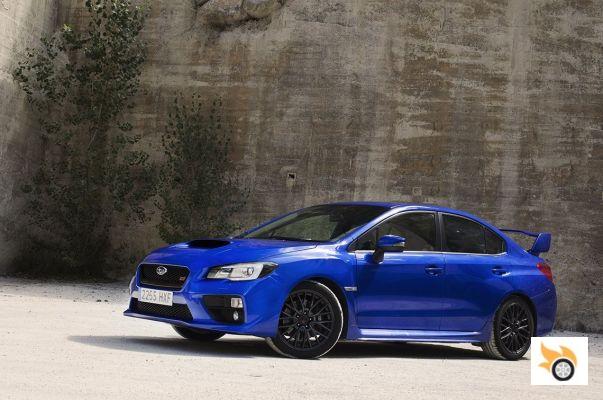
This time, in addition to integrating wide fins, air intakes and a huge spoiler, the designers have also worked on the surfaces
And we'll start our analysis, it couldn't be any other way, with the aesthetics. This is complicated with a Subaru. When the company, back in the early nineties, launched the Impreza, it created a car "Japanese style", of the time. That is, it created a compact without design. A car that had everything "generic". Not a styling line, not a trim. For the WRX and for the STI, he used the typical wardrobe background to create a sporty variant: the biggest imaginable spoiler, a bumper with many air intakes, and an epic air intake in the bonnet to cool the intercooler.
The frameless doors for the window were a license to "sporty" the car, but they brought with them aerodynamic noises and water leakage problems in the long run. But the rest of the car was just a three-volume with rounded edges and a standard horizontal look.
So when the car won the hearts of enthusiasts, the problem of reinterpreting it grew exponentially. Because if you have a starting model with a certain design, you can always evolve it, keep some aspects, integrate new ones, and keep the DNA intact. But Subaru had no DNA to keep, so they used the few resources they had left, but it didn't work out too well. Only beastly wheel arches, epic spoilers and bonnet air intakes plus gold rims created a continuation line until 2008 when a product with "design" was launched. And it got messed up, because the 2008 product didn't sit well with the brand's fans, who saw it as too different from what had come before. Too rounded and good-natured.
So, for the new Impreza, the company decided to bring back some more of the original DNA. How? Well, starting at the front, with more rectangular headlights, less squashed, accompanying a large trapezoidal grille. The lower part of the bumper says "rallyes" just by looking at it, while the bonnet shows the typical air intake, although much better integrated than ever.
We move to the front three-quarters to see a cabin that starts earlier, with the A-pillars more advanced than in previous generations, which detracts from the hood, and helps disguise that this goes higher than before. The front wings are muscular and flared from the Impreza from which this car is derived (though not referenced in the name), but are much better integrated than in past generations. The fin is also topped with a sort of aluminum detail that reads "STI" and crowns the top of an air outlet that serves to empty the front wheel arch of high pressures, as the best sporting practices dictate.
The doors integrate a frame, as engineering logic dictates if you want to achieve good sound insulation and good results in the event of a crash. The roofline evolves to a very slim C-pillar, which accompanies the rear window without sacrificing too much headroom in the rear row of the passenger compartment.
The elbow of the rear side window and the shape of the C-pillar are clearly and intentionally reminiscent of the first WRX STI.
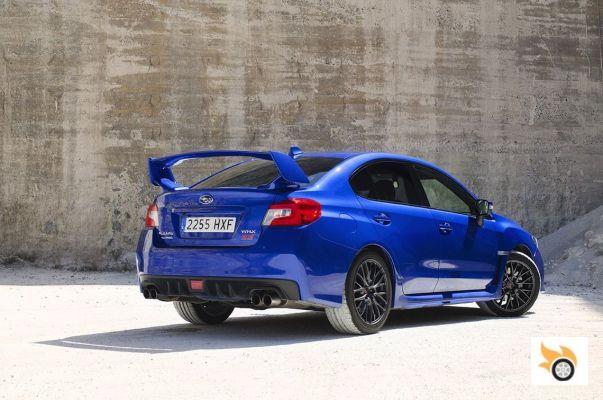
This time around, Subaru's designers have worked a lot more with the side sheet metal surfaces. The rear wheel arch is "muscled" on the body itself, and plays on its forms with the waistline, which after a "jump" in the front wing, is pulled upwards to denote dynamism, while the bottom of the doors has a concave game (note the reflection of light in the photos) that gives "power" and subtracts weight to the side, the WRX STI.power" and subtracts weight to the side, while everything is topped by the extremely wide side skirt that connects both wheel arches and that, frankly, is powerful and great.
The butt is topped off with a huge spoiler, which rises just enough to not bother the rearview mirror and work with a clean stream of air (although by the angle of attack of the spoiler, it seems that little work actually does), and four huge exhaust tails are integrated. If there's one view that's intimidating on this car, it's the rear, hands down.
The end result is striking, it turns heads, but it will never be worthy of a museum of modern art.
The wheels, unfortunately, are not gold (that was reserved for the limited edition launch), and have a spoke design that hides behind rigid brake calipers in the front.
All in all, if I have to make a judgement on the aesthetics of the car, I'd say it's the best designed STI in history. It's the one where the most work has been done to give it character and personality, while at the same time trying to draw on historical heritage to maintain references to the original STI. Did they achieve their goal? Well, the truth is that it's a car that works for me. It's clear that I'm not passionate about it, and it's far from being one of those cars that you say "it's beautiful from minute one", but at least now it's more than just a three-volume car with spoilers and big bumpers. It's a car that also knows how to show that it's not "just another one". Perhaps that in turn can be a problem for those who don't want to be conspicuous, because it's not a discreet compact sports car, and it turns heads. But at the end of the day, that's what the STI customer demands too, isn't it?
Cabin
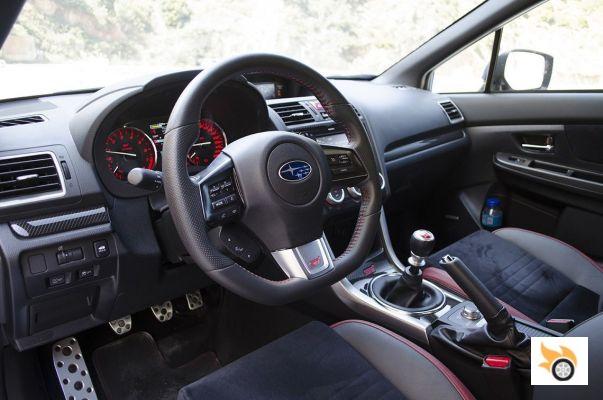
The cabin is typically Subaru: lots of information, good materials, finishes and fittings, but no search for design and ornamentation.
I open the door and climb inside to detail it for you. Blimey, this has more buttons and screens than a Eurofighter Typhoon! OK, it's true, it doesn't have as many buttons as the Opel Astra OPC where you have to do a master's degree to understand what each one is for. The problem, if you can call it a problem, with the WRX STI is different.
If, at least on this occasion, a designer has been hired to create the surfaces of the bodywork, the interior, the cabin, they have left it to "my kind", to the engineers. And since we are the way we are... they have dedicated themselves to placing things as they saw fit, without investing money in "dressing it all up" in a more pleasant way.
The dashboard is practically identical to that of the Subaru XV that we tested here months ago, and that of any of the current Imprezas (which, as I said, are not sold here). So we have some adjustments and materials of good quality, but with a "peculiar" format. The instrument panel is complete and easy to read. It has between both dials a digital display that is operated from three buttons on the side of the steering wheel that seem to be taken from a decade and a half ago. The curious thing is that this little screen doesn't offer you all the information from the on-board computer, and the most surreal thing is that to reset the partial kilometres you have to press a button on the display itself like those analogue mileage displays from two decades ago or more.
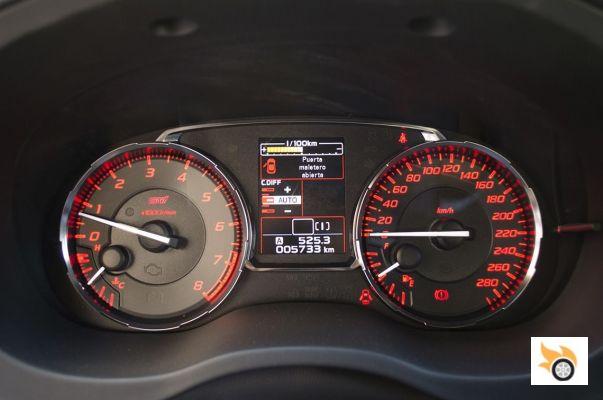
Getting to grips with what each screen tells you and which controller is used to operate it will take some time.
Here there is no place to mark average consumption. At the top there is a bar that moves from one side to the other if we improve or worsen the average consumption we have (a kind of instantaneous consumption indicator to play with to save), followed by variable information below, with an indicator of the centre differential programme we have chosen, another indication of the accelerator programme and the odometers.
As in other cars (Alfa Giulietta) the guy who translates the information on the central display into Spanish had had a few too many drinks before doing his job, so inevitably he got it wrong. You might read that the boot door is open. You might get out three times to close it, each time louder and louder, even though the spoiler is starting to rattle and your wife is looking at you with a "you're going to break it" look on her face. It turns out that "trunk door open" means right rear door closed wrong. I find it hard to believe that no one at Fuji Heavy Industries noticed the flaw before launching the car onto the street.
If you look to the left, towards the center console, there are two other screens. The top one gives information on average fuel consumption, turbo pressure, torque distribution between the wheels, shows the image from the reversing camera, and also allows you to configure certain aspects of the car. The bottom screen is the infotainment system.
The problem is managing these systems. The top screen is managed from an archaic button located between the air vents, which moves up and down and you have to press it as well. The infotainment system's touchscreen isn't an engineering prodigy, and it's far from offering an interface on par with the competition.
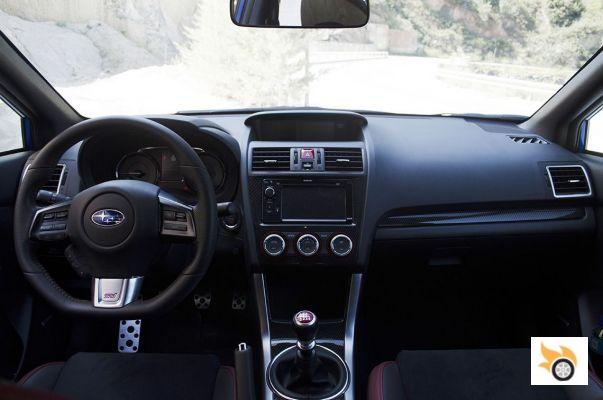
But beyond those isolated "component-by-component" sensations, the biggest issue is one of ergonomics. Although all the controls are within easy reach of the driver, the mess you have to make in your head in the first few days of use to know where everything is and with which control is operated is memorable.
Yes, certainly if you buy this car you'll end up getting used to its controls, and it will stop being a problem, something that I'm sure some Subaru owner will remind me, but the truth is that the competition has much better solved these aspects of organization, and they achieve it with a more elaborate and attractive design. At least you have the peace of mind that it is a car "bombproof" in its qualities and adjustments, so the interior has all the appearance of aging better than others. Of course, the "carbon fibre look" plastic doesn't convince us...
But beyond ergonomics, let's focus on the driving position. As a good Japanese car and a good Subaru, it's easy to feel comfortable. The steering wheel falls where you want it, after several depth and height adjustments. The seat is comfortable and grippy, this time with a separate headrest that's better positioned to fit your head. The bottom bracket is also perfectly positioned, and allows you to play with the heel toe (more on that later). To our right is the gear shifter, which integrates the system that shortens its travel as standard, and behind it are two controls. One is a circular dial to choose the throttle program (linear response, or more radical response from the first ankle movement, as well as a "smart" program). The other is the electronic center differential program selector. You can leave it in intelligent automatic mode, or play with more or less lock, to send more or less torque to the rear wheels.
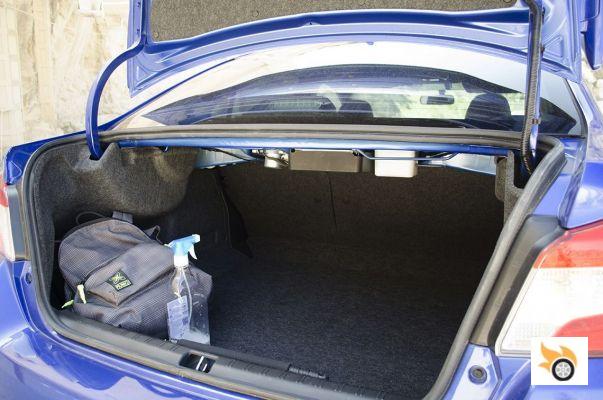
The driving position is perfect, the seats are comfortable, the space in the back is generous and the boot is spacious.
Visibility is more than good in all directions, and although the C-pillar falls very long and there is a huge rear spoiler, the rear of the car is well controlled, leaving the plane of the spoiler (see photo below) at the height of the roof, so as not to obstruct the visual of what comes behind us.
The space in the front seats is more than adequate for adults of any kind, while the rear seats grow to a point where a D-segment saloon doesn't make sense. This is a fully family car in that sense, supported by a generously sized boot, to which we can only put two buts: the narrow load opening, and the lack of trim, which leaves it very "raw and industrial". Opting for a variant with a tailgate would be more useful for carrying large objects, but would pose problems in terms of rigidity of the monocoque.
With 460 litres of boot and the extra space for the rear seats, I can tell you that you can do with it the "civilian" life that anyone requires, for space, even if you have a baby or two at home and a dog and you have to go shopping for the month. Of course, you won't go unnoticed in the shopping centre car park...
Technique
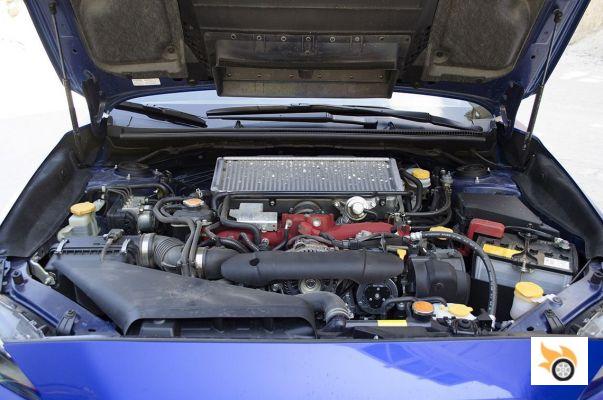
The new STI is perhaps not as new as some of us had hoped. Subaru has decided to completely revamp the chassis and drivetrain, but has left the engine, gearbox and final drive train intact compared to the previous generation.
As for the chassis, the monocoque is torsionally stiffened by no less than 40%, incorporating new reinforcements and also modifying the steel alloys used in the stampings. On paper, with a stiffer chassis one could opt for a softer suspension without the risk of losing dynamic qualities, but Subaru has gone in the other direction.
Engine, gearbox and transmissions are taken directly from the previous generation.
After numerous criticisms of the previous generation's tuning, and especially the sluggishness of the front axle, as well as the lack of steering feel, Fuji Heavy Industries have gone the other way... heavy, stiffening the spring and stabilizer settings at all four corners.
The McPherson front axle modifies its subframe, integrates stiffer bushings and ball joints, adds 20% stiffness to its springs and increases the diameter of its stabilizer. The rear axle also modifies its spring rates (+6% in stiffness), increases the rear stabilizer and is anchored on new stiffer ball joints.
The steering is another major change, becoming much faster (13:1 gear ratio), sitting on a stiffer column (125%) and retaining the hydraulic assistance. The goal? To improve the delivery of information to the palms of the hands and facilitate quicker steering changes.
The engine is the same 2.5 boxer supercharged by a single turbocharger, with indirect injection and variable valve timing, delivering 300 hp and 407 Nm of torque to all four wheels via a six-speed gearbox (remember, with short-throw gearbox that was previously optional). There's a multi-disc active centre differential that responds to commands from the electronic system we told you about above, and it's accompanied by a self-locking ramp differential on the front and a Torsen differential on the rear axle.
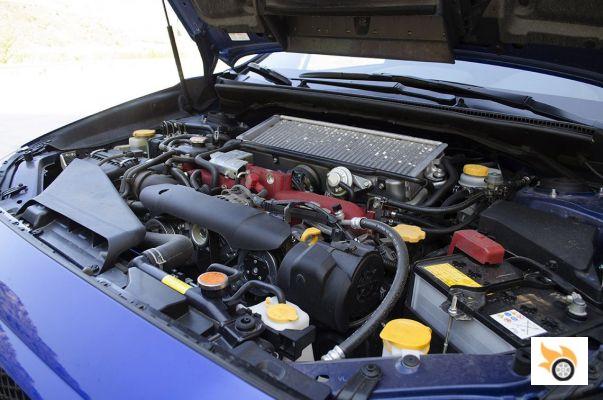
What were we expecting for this generation of the WRX STI? Well, a lot more changes to the engine. We expected the arrival of direct injection, a new supercharger system (more on that below), and also expected a new dual-clutch gearbox as an option (which we know for a fact the firm has in development).
Instead, the engine is "as is". And there we find it, when we open the bonnet, accompanied by a battery with maintenance and electrolyte level to check, in an engine that lacks any plastic cover to decorate it with. That's a good thing, in our opinion, especially considering that this is a car for connoisseurs.
The problem is whether this "old-fashioned" recipe that Subaru applies serves to offer a sufficiently convincing result on the road to continue to love, while correcting errors of the previous generation.
Driving on the attack!
So let's forget about lengthening the description and let's get into the situation. You already know it from other times: three chained passes, starting with a very fast one with asphalt in perfect condition, followed by one much slower but with good surface, and a final stretch with broken and narrow asphalt that combines fast areas with very very very slow areas.
That combination has to be used to guess what the WRX STI hides under its new skin. After putting on the Alpinestars and going down to the garage, I start the engine and the unmistakable Subaru barboteo, due to its unequal exhaust manifolds, floods the garage with an omnipresent smell of gasoline. As I get out and the fluids warm up, the first thing I notice is the clutch bite and the physical efforts of driving an "old-fashioned" car.
Interestingly, the new STI has the lightest clutch of the whole saga as far as I can remember, but it's still harder than its rivals. Plus the bite it has is violent, so getting out of a stop smoothly requires concentration or a dose of intentional clutch slippage. The gearbox offers very short travel and a very mechanical and positive feel, but it also has a trade-off for it: With less lever arm, moving it becomes much harder and more demanding.
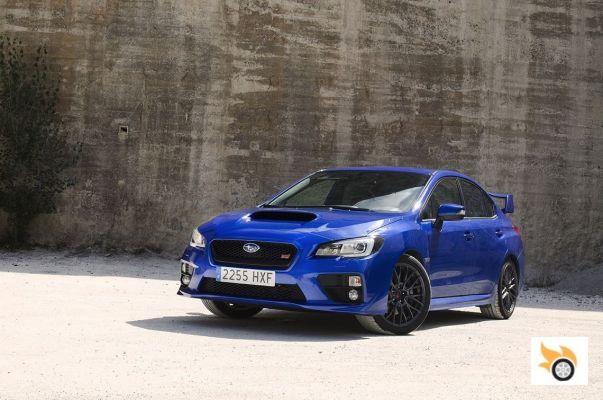
Power steering is inconsistent on long, fast inputs
After leaving the slow, urban area, I head down a long straight road towards the pass. Full throttle and the EJ257 engine is sluggish while the supercharger reaches the right load level and speed. Then the torque arrives in torrent form, and the car starts to push with real panache.
It doesn't take long to realize that we're back to where we were before: With the STI you have to work with the (relatively short-ratio) gearbox to keep it in the good zone, between peak torque and peak power. Besides, the new EJ257 "reinvented" with the new ECU seems to want to go higher on the rev counter, feeling more comfortable even after the revs at which it achieves its maximum power than when you ask for something below 3,000 revs.
Another curious aspect of the engine, when compared to more modern engines, is the presence of lag. We've become accustomed to the fact that modern turbocharged cars barely have any lag between pressing the accelerator and the turbocharger starting to work. But Subaru has a basic engineering and design problem here: In a turbo engine, the time it takes for the exhaust gases to exit and reach the turbocharger sets the tone for how much lag you're going to feel (the other major factor is the inertia of the turbine, which the bigger and heavier it is, the longer the response will be delayed).
In a boxer engine like Subaru's, when using a single turbocharger, the exhaust gas path is always inherently long, as the turbo can't be glued directly to the exhaust manifolds, as is now being done in more modern inline four-cylinder engines. Subaru could solve this by incorporating two turbochargers, one per bank, but this would involve more weight, more complexity, and also more cost. Plus, the WRX STI uses a turbo that isn't exactly small. So if you add one plus one, you get two: it's an "old school" turbo engine, one of those that you have to know how to squeeze to get the most out of it.
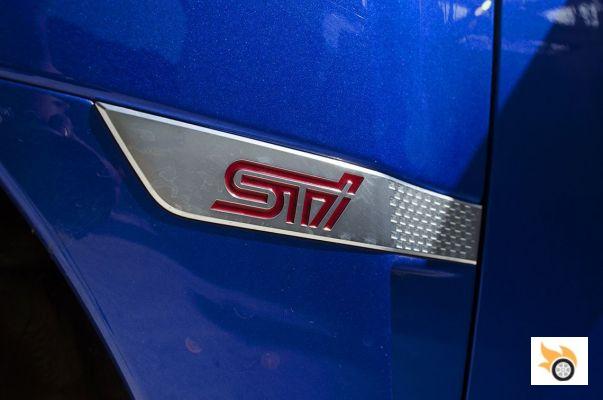
Understanding the idiosyncrasy of the engine, I face the first curves determined not to let the boxer fall from its good area of use. Foot on the brake and the powerful four-piston Brembo rigid calipers bite the front discs with panache to stop the STI with desire. Power is good, but pedal feel isn't as excellent as in the BRZ. There's not as much room for modulation.
The engine has to be treated like one of the old ones, keeping it in its good zone and watching the lag, but it has character, punch and sound.
The gearshift, which in civilized use comes across as a bit clunky and harsh, when you're on the attack proves to be much more rewarding, while the pedals help you accomplish the downshift from sixth to third with a textbook three heel-toe (or two if you skip a gear in between). With the car still wide open, I turn my head and glimpse the apex of the corner. Now, with the A-pillars more advanced, you can see better what's ahead and around you in this STI. I put the steering wheel in to steer the maneuver and I'm surprised. The car turns instantly and with unusual eagerness, as if it were a fighter jet, like an inherently unstable Typhoon waiting to change trajectory at the slightest hint.
Wait... I've been taken for a ride? The closest I've seen to a front end like this was in the Lancer Evo X (or the IX, third and fourth citations to Mitsubishi in the article). Subaru had always made the STIs lazier cars in responding to the demands of the front end, right down to the complaints of the latest STI. And now, all of a sudden, they've radically changed their approach. Of course, this was foreseeable: the front end is much stiffer, and the steering much more direct.
Under the new demands of the script, with the new geometry and the new demands of the car, Subaru has magnified the degree of steering assistance, and it shows, because the steering wheel feels lighter from the first degree of turn you introduce to throw you to the apex.
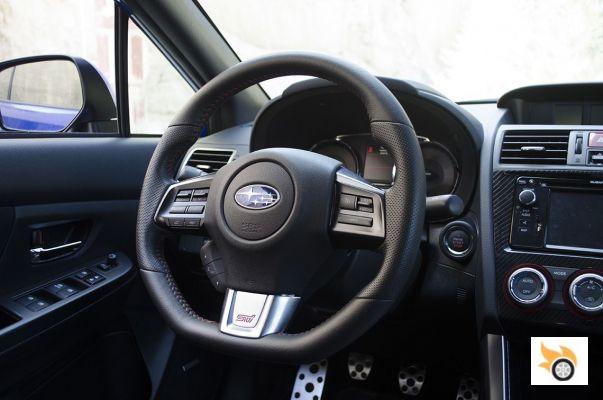
The cornering grip is simply phenomenal, and the rear, once you're coming out on full throttle, yaws the trajectory to round the corner.
The car changes from straight to lean in less than the blink of an eye, and you're already travelling towards the apex. The nose feels much more solid than in the previous generation. For a start it doesn't pitch under braking, and for a follow up, the stance is much more direct. But there is one problem that, in a fast third corner like this one, immediately comes to the fore: the steering assistance. Having such quick and responsive steering has a toll to pay, and that's that you can't make fast lines in this style of corner cleanly, as you're constantly correcting the trajectory, because the degree of assistance isn't consistent. You don't set a trajectory and the steering wheel "stays there hard", it seems to constantly want to change position. And no, it's not a problem of chassis configuration or tuning, because the car wants to go where you've told it to go, but it's the assistance that, by lightening the steering so much, makes us have that little "dance".
I give hard gas before arriving to the exact apex to start straightening and braking because after this corner comes another second corner with braking in support on the left. As a good STI, you can give gas without contemplation, you don't have any grip problem. The car passes torque to all four wheels intelligently and manages to pull you forward if you've been clever enough not to let the engine fall out of its good zone and you've anticipated the lag problem.
Braking in support is no problem at all, and unlike other cars, it's not backwards "hunting", even if you're coming in a bit overdriven. I take it out of gear with another heel-toe and head for the second corner, where I find the limit of grip. Again the steering surprises me. To the mentioned problem of the lack of consistency in the assistance, is added the fact, which is not new, that it doesn't inform me when you lose grip in front. And it's complicated that with so much assistance you can inform with a lightening of the steering that you're overdemanding to the steering wheels, something you'll know by its sonorous whines and a nose that barely opens the trajectory. I ease off the throttle a hair, the car regains its composure, and I can immediately move into full attack to go for the next straight.
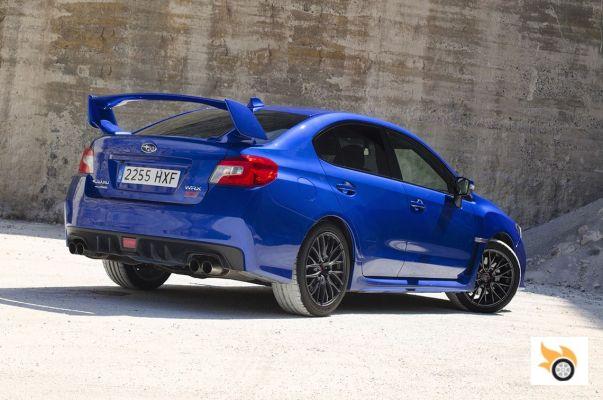
So the kilometres and hours go by. After 90 minutes I'm already in the roughest and roughest area. It's here where the new suspension proves to be too hard to work well with the broken asphalt. The car absorbs the irregularities and keeps the tires glued to the asphalt, with a perfect job by the shock absorbers in their hard struggle to counteract the energy of the springs. But you can't help noticing some uncomfortable bouncing and vibrations that the STI didn't have before. Of course, the slower the corners get, the less of a problem I have with the ultra-quick and inconsistent steering, something that also helps that I've gotten used to the way it's set up.
I start playing with the various manual settings of the center differential, and send more torque to the rear axle. If there's not too much grip and you're convinced to apply all the torque at the exit of corners you can yaw the rear of the car to round the corner almost to the millimetre. If you leave the differential in automatic mode and go all out, the control unit will pick up on this and you'll end up with pretty much the same result. The most impressive thing about this is to see how you can accelerate without any consideration and take advantage of the power to close the lines without turning them into wide understeer.
The change of settings to a car with a much more "responsive" nose on corner entry has surprised me.
I return home to reflect after the thrashing, which leaves me with a sore neck and tiredness, but with a smile and satisfaction of having had a good time, although the brakes creak and hiss in the last kilometers that I drive, slowly, to reach my destination.
What does the new STI have that it didn't have before? where does it fail? It has something that doesn't convince me, but at the same time it's an addictive car in its behaviour... It's something... strange.
If we start by evaluating the engine, we already find the first drawbacks. What was once an engine with character, powerful and exemplary, now meets rivals that offer the same performance, spend less, and above have a much better throttle response, more immediate. The 2.0 TFSI Volkswagen Golf R or Audi S3 is a good example. Subaru's boxer has more character, from its sound to its "kick" and its desire for final stretch. But at the end of the day, it is already outclassed by the mechanics of the others.
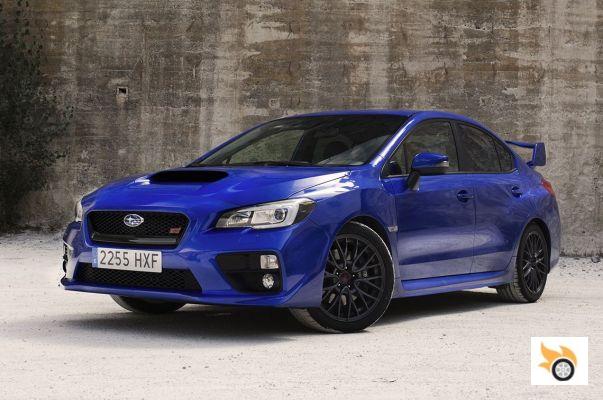
If we continue with the chassis, I'll tell you that the radical change in tuning also surprises me. The WRX STI has gone from being "like an STI" to being more like a Mitsubishi Evo (that's five). Anyone who has driven an Evo (six) will remember how the car throws itself into corners "almost unintentionally" and how it rounds them with the rear end. The STI is now much closer to that than it is to having that lazier nose it had before. The problem is that, as a general rule, with this geometry change and this radicalization it's also easier to lose nose sooner when you overdo it demanding grip, although you can always compensate by controlling the rear and throttle.
The extra stiffness of the suspension and the monocoque make the new STI a beast on tarmac in perfect conditions, but when the going gets tough, it seems too stiff to deal with broken and cut asphalt, especially if you go to low grip surfaces. Before you could put a WRX STI on a gravel or dirt track and with the standard settings it was a competent car, now it's so stiff that it feels like a car made for asphalt, where some grip on slippery surfaces has been sacrificed to get a "black asphalt devouring machine". Considering the type of use that the customer will give it, I can consider it a success (the one that runs rallies already changes the suspension for it), but it still surprises me.
On dry asphalt it is ultra-efficient. And the engine, without making it the fastest compact sports car on the market, has character and bravura. In the end, the funny thing is that I can complain about a thousand aspects that I would polish or change in a 2014 car, but the WRX STI, despite all these flaws and oddities "old school car", you get smiles, and go home satisfied with your sections and with the car. It has "that intangible something" that you want in spirited driving. In fact, it has more of that something than Subaru's own BRZ...
And to live day by day with him?
It consumes a lot, the clutch is hard and has a dry bite, and is hard on suspension, so for civilized use there are better options among sport compacts.
Despite everything I've said, I have to admit that the Subaru is engaging, and that the more you drive it in bends, and the more you get to know its virtues and defects, the more you enjoy it. But how does it perform as a "car for everything"?
Well, it all depends on what you compare it to. On the one hand, on the open road it offers an acceptable ride silence (by acceptable you mean that it's not the best in its category, but it won't be a head-turner), it's tremendously safe (Subaru's reputation in this regard is on the rise, according to the results published by the NHTSA), and the Harman Kardon audio system is simply spectacular in its richness of tones and volume capacity. The climate control works perfectly and there's plenty of room for people and gear.
The problems come when you face bumpy roads, where comfort suffers. If you move around town, you'll get tired of its hard clutch and gearbox. And if you're worried about fuel consumption, I have bad news for you, because averaging 11 litres per 100 kilometres, even if you don't demand anything from the engine, is easy (in the whole month I managed to make a tank with an average consumption of nine litres, driving smoothly in a mix of city and highway).
Comparisons are odious, but necessary in these cases, and the misfortune for the STI is that there are cars just as fast and effective, which do not spend as much and above are more useful in everyday life.
Conclusions
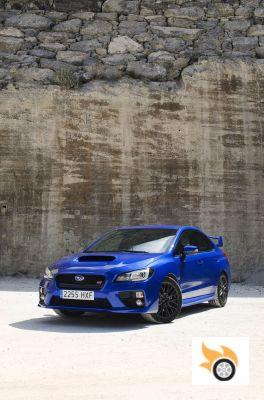
It is difficult to draw clear conclusions: it is fun and passionate for those who want a Group A street car, but at the same time there are more effective and versatile options on the market.
And this leads us to draw conclusions. Confusing conclusions after a month shared with the WRX STI. The good thing about the car is that in a world where it seems that cars with character and personality are dying out, the STI continues to do things its own way. And when, in the midst of corner-to-corner fervor, you look in the mirror or stop for a moment to rest, you'll find yourself satisfied with the experience.
But the problem is that the STI is still stuck in the past. It has barely evolved conceptually from where it started. And if it used to be "the king" along with the Evo (seven times already) in sport compacts, that's no longer the case.
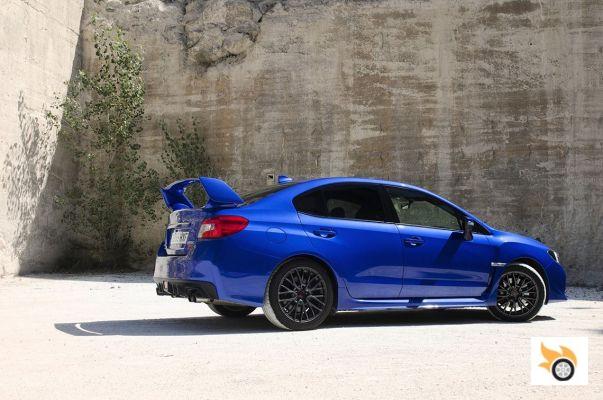
A Golf R (which we're testing this week), offers similar cornering effectiveness, an equally entertaining drive and on top of that it's faster and more competent on a day-to-day basis, spending less and being much more comfortable. Of course, it lacks the character, sound and badass image of this STI. BMW's M235i, which doesn't follow similar lines to an all-wheel drive car, costs a similar amount, and as with the Golf, and as we've told you, it's a much more complete and elaborate car.
But does all this detract from the STI? I doubt it. The good and bad thing about this Subaru is that it's made by and for specific lovers of a specific type of car. With the Evo in imminent extinction, euthanized, there's only going to be the STI left for those looking for a "Group A street car". Not many of us are willing to sacrifice aspects of everyday life to have a device like this, but the niche, globally, takes enough volume so that Subaru is still interested in investing in producing this beast of the asphalt, that with all its buts, still has character to capacesos. I don't know if it's investing because it's profitable, or because the STI is still the perfect halo car for the brand.
But, gentlemen of Fuji Heavy Industries, please, for the next iteration, keep the good things about the character, but apply yourselves to bringing the car up to date. It would be enough with a better interior design and ergonomics, with mounting two smaller turbos and direct injection to reduce lag and fuel consumption, with... Stop, stop, wouldn't we then be killing the original concept of the STI? I'm going mad. And that's not even getting into the fanboy argument about whether this STI is "more Lancer Evo than ever" (that's eight, and I'm afraid the Subaristas are already coming towards my house with pitchforks and torches). I'll leave you to it, I'm going to hide.
Article originally published in September 2014, retrieved for Pistonudos
























